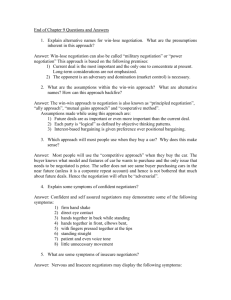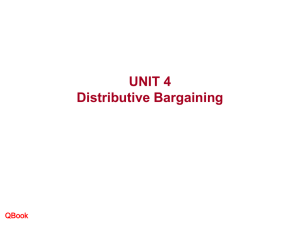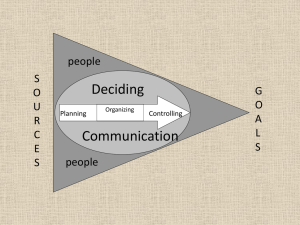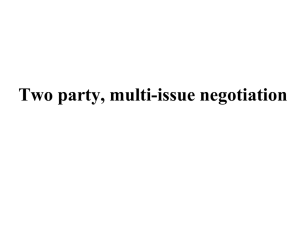Negotiation Versatility Part 1- Strategy and Tactics
advertisement
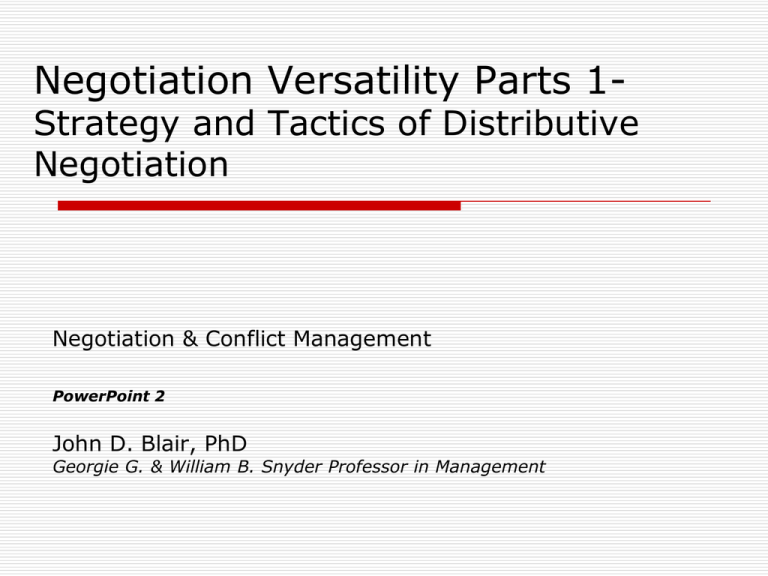
Negotiation Versatility Parts 1- Strategy and Tactics of Distributive Negotiation Negotiation & Conflict Management PowerPoint 2 John D. Blair, PhD Georgie G. & William B. Snyder Professor in Management The Distributive Negotiation Situation Goals of one party are in fundamental, direct conflict to another party Resources are fixed and limited Maximizing one’s own share of resources is the goal Preparation—set a Target point (aspiration point) Resistance point (walkaway point) Asking price (initial offer) 2 The Distributive Bargaining Situation—Walk Away etc. Party A - Seller Walkaway Point Target Point Asking Price Potential Area of Negotiation Most Likely Area of Negotiation Initial Offer Target Point Walkaway Point Party B - Buyer 3 The Role of Alternatives to a Negotiated Agreement Alternatives give the negotiator power to walk away from the negotiation If alternatives are attractive, negotiators can: Set their goals higher Make fewer concessions If there are no attractive alternatives: Negotiators have much less bargaining power 4 The Asymmetrical Distributive Bargaining Situation— Only One Party Has Very Good BATNA Party A - Seller Walkaway Point Target Point Asking Price Potential Area of Negotiation Alternative Most Likely Area of Negotiation Alternative Initial Offer Target Point Walkaway Point Party B - Buyer 5 The Distributive Bargaining Situation—Both Have Weak BATNAs Party A - Seller Walkaway Point Target Point Potential Area of Negotiation Most Likely Area of Negotiation Asking Price Weak Alternative Zone of Potential Agreement Weak Alternative Initial Offer Target Point Walkaway Point Party B - Buyer 6 QUANTITATIVE STRUCTURE OF THE NEGOTIATION—A Specific Example Note: Aspirations shown here are for illustration; the actual aspirations formulated by participants will vary. Reservation prices are given fairly precisely in role instructions. ZOPA = Zone of Potential Agreement Goals/Interests: -Purchase 10,000-18,000 units -One Shot Deal BATNA = No Alternative Source Buyer’s Aspiration Buyer (AccelMedia) 5 15 10 Buyer’s Reservation Price 20 25 30 35 40 45 ZOPA Seller (GTechnica) Seller’s Aspiration Seller’s Reservation Price Goals/Interests: -Sell up to 15,000 units -One Shot Deal BATNA = No Alternative Buyer 7 Fundamental Strategies Push for settlement near opponent’s resistance (walkaway)point Get the other party to change their resistance point If settlement range is negative, either: Get the other side to change their resistance point Modify your own resistance point Convince the other party that the settlement is the best possible 8 Keys to the Strategies The keys to implementing any of the four strategies are: Discovering the other party’s resistance point Influencing the other party’s resistance point 9 Tactical Tasks of Negotiators Assess outcome values and the costs of termination for the other party Manage the other party’s impressions of you Modify the other party’s perceptions of your offers Manipulate the actual costs of delay or termination to you or to the other party 10 Assess Outcome Values and the Costs of Termination for the Other Party Indirectly Determine information opponent used to set: Target Resistance points Directly Opponent reveals the information 11 Manage the Other Party’s Impressions of You Screen your behavior: Say and do as little as possible Direct action to alter impressions Present facts that enhance one’s position 12 Manage the Other Party’s Perceptions of You & Your Offers Make outcomes appear less attractive Make the cost of obtaining goals appear higher Make demands and positions appear more or less attractive to the other party –whichever suits your needs 13 Manipulate the Actual Costs of Delay or Termination Plan disruptive action Raise the costs of delay to the other party Form an alliance with outsiders Involve (or threaten to involve) other parties who can influence the outcome in your favor Schedule manipulations One party is usually more vulnerable to delaying than the other 14 Positions Taken During Negotiations Opening offer Where will you start? Opening stance What is your attitude? Competitive? Moderate? Initial concessions Should any be made? If so, how large? 15 Positions Taken During Negotiations—Concessions etc. The role of concessions Without them, there is either capitulation or deadlock Patterns of concession making The pattern contains valuable information Final offer (making a commitment) “This is all I can do” 16 Commitments: Tactical Considerations Establishing a commitment Three properties: Finality Specificity Consequences Preventing the other party from committing prematurely Their commitment reduces your flexibility 17 Abandoning Commitments Ways to abandon a committed position Plan a way out Let it die silently Restate the commitment in more general terms Minimize the damage to the relationship if the other backs off 18 Closing the Deal Provide alternatives (2 or 3 packages) Assume the close Split the difference Exploding offers Deal sweeteners 19 Typical Hardball Tactics Good Cop/Bad Cop Lowball/Highball Bogey (playing up an issue of little importance) The Nibble (asking for a number of small concessions) Chicken Intimidation Aggressive Behavior Snow Job (overwhelm the other party with information) 20 Dealing with Typical Hardball Tactics Four main options: Ignore them Discuss them Respond in kind Co-opt the other party (befriend them) 21


